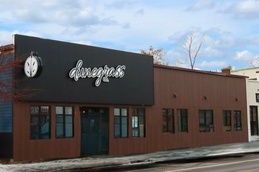
Walter Hagen's Northern Michigan
When one of the world's best golfers called Up North home.
By Patrick Sullivan | June 29, 2019
Imagine this: One of the biggest sports stars in the world lives in Traverse City. He’s retired and a bit pudgy now. He’s been weathered by years of drinking and chasing women. No doubt he’s past his prime.
But every day, he hangs out at Little Bo’s. On West Front Street. It was kind of a dive bar back then, but that’s where he went and bought people drinks and told them stories. And one time, from the payphone at the back of the place, he called the United Kingdom so that he could congratulate Arnold Palmer on his first British Open win.
Little Bo’s isn’t a dive bar anymore. New owners have taken over and it’s called Little Bohemia Tavern now. But they still celebrate the golfer who once owned a table near the front of the place, to the left of the bar in the corner.
“This was his self-proclaimed home away from home, because he liked to do this,” said Little Bohemia’s owner, Nancy Freund, as she made a drinking motion with her hand. “Daily, he was here.”
LIFE’S 19th HOLE
How did Walter Hagen come to live in Traverse City at a time when he was just as famous as (and sometimes hung out with) Babe Ruth?
Though Hagen was born and raised in Rochester, New York, and got his start at a golf club there, Hagen moved to Detroit as a young man and made that city his home base throughout his professional career. As he got older, Hagen did what successful Detroiters did: He got a place Up North.
“Wintering in Detroit made him a Michigan guy, and where do Michigan people go for fun in the summer?” said Gary Wiren, master member of the Professional Golfers Association of America and senior director of instruction at Trump International Golf Club.
Wiren, whose wife is from Traverse City and has been coming to northern Michigan every summer since 1959, was awestruck when he met Hagen at the Traverse City Golf and Country Club in 1960 during Hagen’s eponymous tournament.
“It was a short [encounter]. I didn’t have a long time with him, although I subsequently learned so much about him,” he said. Wiren would go on to amass one of the largest private golf memorabilia collections in the world, and a lot of it is focused on Hagen.
Wiren said anyone who wants to learn about Hagen should start with his autobiography, “The Walter Hagen Story,” published in 1956. (It is available at Traverse Area District Library.)
The last chapter recounts some of Hagen’s favorite bars, one after another, at famed golf courses across the country, and he recounts the people who he drank with in those bars.
“I suppose every joker who knows one golf club from another is familiar with my tendency to get around the course as quickly as possible and bend an elbow at the 19th hole, a favorite on any course,” he wrote.
Hagen’s 20-acre estate on Long Lake, which he bought in 1954, became his life’s 19th hole.
“In all my wandering around the globe, I never really owned a home. This, my first, is situated on a knoll facing west on Long Lake near Traverse City, Michigan. My picture windows look out on the silvery blue waters across to the island some half mile distant,” he wrote. “Now instead of counting the strokes on each hole I count the tall and slender white birches, the spruce, the hemlock, the maples and cedars on my acres on Long Lake … the nineteenth hole on the Haig’s course.”
BUT FIRST, CADILLAC
Traverse City wasn’t Hagen’s first foray into northern Michigan. Before Traverse City, Hagen stayed for a year in Cadillac, a place he chose to start work on his autobiography.
“Filled with enthusiasm and determination and armed with scrapbooks and typewriters, I retired to Cadillac, Michigan, to begin work,” Hagen wrote in his book. “Why Cadillac? For a fellow who has followed the sun around the world all his life it may seem queer to choose a northern Michigan town blanketed with snow almost eight months of the year.”
Actually, he wrote, he put a lot of consideration into where he ended up. He picked Pilgrims Village, a resort on Lake Mitchell, because the place rented enough cabins to house him and whoever he needed around to help him write his books (he called those folks his “literary kibitzers”). More importantly, though, he chose Cadillac because it was so far from Detroit, his full-time home.
“If I had taken a place on any lake near Detroit, or at any resort area where I’ve lived or played golf, people will just happen to be nearby and dropin. But Cadillac is 200 miles from Detroit,” he wrote. “If they came there to toast my labors, they wouldn’t be dropping in, they’d have to aimat it to get there.”
The first thing Hagen did once he got to Cadillac was to purchase a 20-foot boat with a “lively” motor that he enjoyed with his friends in lieu of getting work done on his book.
“’Let’s not be in a hurry to start this book,’ I suggested the day we arrived. ‘There’s plenty of time.’”
(That might explain how Hagen arrived in Cadillac with Charles Price, a golf writer and historian who had signed on to co-write his biography, but that the book was actually finished several years later with the help of a replacement writer, Margaret Seaton Heck.)
Hagen said he even constructed a 12-by-12-foot extension to the dock in front of his cabin to make a sitting area where he could fish and work on the book. He said that he also had constructed deck railings coated with an aluminum phosphorous paint that glowed in the dark to make losing anybody to the lake after a night of drinking less likely.
Hagen spent a year in Cadillac, enjoying the changing of the seasons, which he wrote were mild that year. He learned how to use snowshoes and to downhill ski.
CHANGING THE FACE OF GOLF
Hagen, who would become famous for being the first golfer to make a million dollars, was born to a working-class family in 1892. Though he grew up wanting to be a baseball player, he came to golf early.
“The truth is I went into the game in the beginning for the money — ten cents an hour plus a nickel tip, which members of the County Club of Rochester, New York, paid their novice caddie, Walter, back in 1900,” he wrote in his autobiography.
Hagen would go on to win more major championships than anyone before him. He won his first, the U.S. Open, in 1914, at the age of 21. He won that tournament again five years later. He won four British Opens.
Wiren said Hagen’s biggest accomplishment was winning the PGA Championship five times and, in one stretch, four years in a row at a time when it was a match play event. To be able to maintain that level of play over consecutive rounds and consecutive years is astonishing, he said.
But Hagen’s allure wasn’t just his dominance on the links. He was known as a fun-loving, decent guy who reimagined what it meant to be a golfer.
For example, Wiren said, Hagen would get to the clubhouse and say to the other golfers, “Hey boys, who’s going to finish second this year?” But coming from Hagen, that kind of comment was not obnoxious.
“It was not him trying to be arrogant or anything — he was just fun,” Wiren said.
In a 1989 Sports Illustrated profile, writer Ron Fimrite recounted Hagen’s remarkable career, but he also explained how Hagen’s legacy is so much bigger than his record. Hagen, through the force of his personality, changed golf from an upper-class pastime bound to aristocratic traditions to a sport that regular folks could play.
Hagen also changed the life of professional golfers.
Fimrite explained: “When Hagen first started playing the game, golf was dominated on both sides of the Atlantic by gifted amateurs — in England by aristocrats, in the U.S. by the socially prominent. Clubhouses were sanctuaries for the members and strictly off-limits to the club professionals. The pro in those days was little more than a servant, an instructor to the rich, a craftsman who fashioned clubs in the quiet of his own quarters, far removed from the social whirl of the clubhouse.”
Hagen changed that through ostentatious dress and by outspending the aristocrats and upper class, until he eventually changed the perception of club pros and was allowed inside the clubhouses.
A FATAL DRIVE
As Hagen’s career wound down in the 1930s, he was involved in a traffic crash that would affect him for the rest of his life.
Hagen was playing in Minnesota’s St. Paul Open in July 1934. On the way back to his hotel after a day of golf, his car struck a 6-year-old boy. The boy was then run over and killed by a streetcar.
Hagen is said to have jumped from his car and cried, ‘Don't tell me you're dead, Sonny. … Come on, speak to me.” Hagen was not held at fault for the crash, but from that time on he nearly gave up driving.
“He hated driving,” said Price, the golf writer. “I'd drive for him, but if I ever went faster than 45, he'd have a fit. ‘What's your hurry?’ he'd say, as cars whizzed by all around us.”
Freund, whose father bought Little Bohemia just weeks after Hagen’s death, 50 years ago, said she heard stories over the years about how Hagen always got around Traverse City with a chauffeur, or he’d arrange to get rides.
“I don’t think he drove at all after he moved here,” she said.
Hagen, in his later years, more or less stopped hitting the links, too.
“He quit playing golf,” Freund said. “I heard he would hit golf balls into the lake, and kids would go diving for them.”
But regardless, he kept getting back to Little Bo’s.
That’s where he decided to call Palmer, to congratulate the young man on his victory in 1961.
In a television interview years later that’s preserved on YouTube, Palmer recalled receiving that call placed from Little Bo’s. Palmer was, at the time, at a bar himself.
“When I won the British Open at Birkdale the first year … I was in the bar having a drink, and the phone rang, and it was Walter Hagen,” Palmer said. “I was very flattered, and I said hello, and we talked. And we had talked before. He was my kind of man.”
The phone call, though, solidified a friendship that endured, and Palmer flew to Traverse City in 1967 to take part in a dinner at the country club in honor of Hagen, who by that time was dying of cancer.
“So, I came here for that celebration, and we laughed and talked about the differences and what had happened in his time and my time, and at the time I was smoking, he was smoking — big time — and we were drinking a little, too,” he said.
At the dinner, Palmer said to Hagen: “If it were not for you, Walter, this dinner would be downstairs in the pro shop and not in the ballroom.”
Two years later, on Oct. 6, 1969, Hagen died at his home on Long Lake at the age of 76.
Trending

Michigan’s Marijuana Tax at Work
Cannabis has become a big business in northern Michigan, and local governments are putting tax dollars earned from dispensar… Read More >>
California Sober: Why People Are Switching from Alcohol to Weed
They call it “California sober.” Generally speaking, this term applies to folks who use marijuana but abstain f… Read More >>
The Legacy of Student Activism
“It’s a physical letter to your representative,” Alex Tank says when asked to define the word “prote… Read More >>


